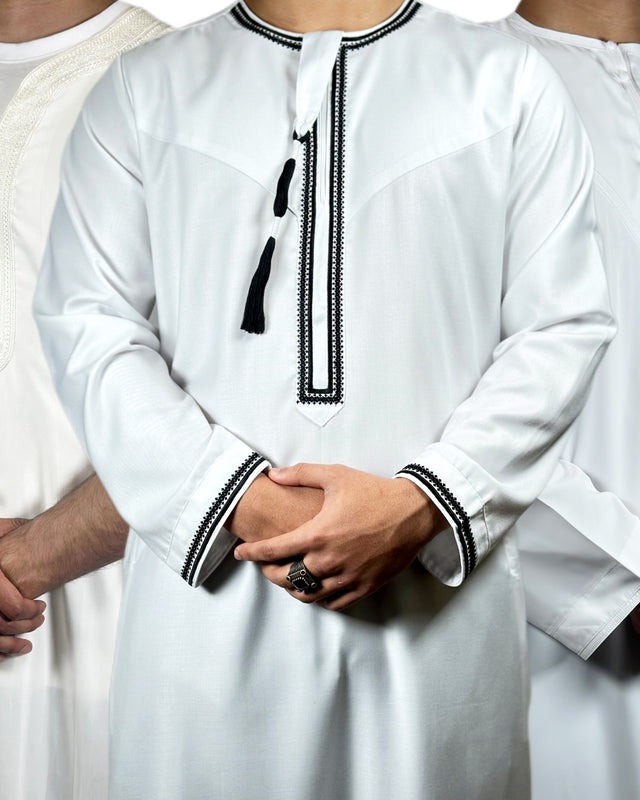The thobe, also known as a dishdasha or kandura, is a long robe worn predominantly by men in the Arabian Gulf countries. Historically, this traditional arabic clothing traces its roots back to ancient Mesopotamian and Arabian attire, evolving over centuries to adapt to the local climate and cultural norms.
Design and Fabric
Typically made from white cotton or wool, the thobe is designed to be loose-fitting to provide comfort in the hot desert climate. In cooler regions or seasons, thobes made from heavier fabrics are preferred. The simplicity of the thobe’s design is often complemented by subtle embroidery along the neckline and cuffs.
Regional Variations
While the basic structure of the thobe remains consistent, there are regional variations. For instance, in Saudi Arabia, the thobe tends to be slightly slimmer with a higher collar, whereas in the United Arab Emirates, the kandura might feature a broader cut and often includes a long tassel (tarboosh) attached to the collar.
The Abaya: Grace and Modesty
Cultural Significance
The abaya is a long, black cloak worn by women across the Arab world, especially in the Gulf countries. It symbolizes modesty and privacy, aligning with Islamic principles of dress. The abaya covers the whole body except for the face, hands, and feet.
Modern Interpretations
While traditionally plain and unadorned, modern abayas come in various styles, incorporating intricate embroidery, beadwork, and even colorful designs. Fashion designers have reimagined the abaya, turning it into a statement of personal style while maintaining its cultural essence.
The Keffiyeh: Icon of Arab Identity
Historical Context
The keffiyeh, also known as a ghutra or shemagh, is a traditional headscarf worn by men. Its origins can be traced back to ancient Mesopotamia, where it was used to protect against the harsh sun and desert sand. Over time, it has become a potent symbol of Arab identity and resistance.
Patterns and Colors
The keffiyeh is typically made of cotton or a cotton-wool blend and comes in a variety of patterns and colors. The black-and-white checkered keffiyeh is widely associated with Palestinian heritage, while red-and-white versions are commonly worn in Jordan and Saudi Arabia.
Wearing Styles
The way the keffiyeh is worn varies by region. In the Gulf, it is often draped over the head and secured with an agal, a black cord. In the Levant, it might be wrapped more tightly around the head and neck, offering protection against the elements.
The Hijab: Modesty and Faith
Religious and Cultural Importance
The hijab, a headscarf worn by many Muslim women, serves both religious and cultural purposes. It signifies modesty, privacy, and moral conduct. The practice of covering the hair is mentioned in Islamic texts, and the hijab has become a symbol of faith and identity for Muslim women.
Varieties and Styles
The hijab comes in numerous styles, fabrics, and colors, allowing for personal expression while adhering to cultural norms. Some popular styles include the Al-Amira, a two-piece veil, and the Shayla, a long, rectangular scarf wrapped around the head.
The Agal and Bisht: Completing the Ensemble
The Agal
The agal is a black cord used to secure the keffiyeh or ghutra on the head. Made from goat hair or camel wool, it is a distinctive accessory that holds historical significance. The agal was originally a practical tool for Bedouins, used to hobble camels, but it has evolved into a symbol of Arab heritage and masculinity.
The Bisht
The bisht is a traditional cloak worn over the thobe on formal occasions. Made from high-quality materials like camel hair or wool, and often adorned with gold embroidery, the bisht is a garment of prestige, worn by leaders, dignitaries, and during significant events such as weddings and religious ceremonies.
The Niqab and Burqa: Cultural Variations in Veiling
The Niqab
The niqab is a face veil that covers the lower half of the face, leaving only the eyes visible. It is worn by some Muslim women as an expression of modesty and religious adherence. The niqab is more prevalent in certain regions, such as the Gulf countries, where cultural practices support its use.
The Burqa
The burqa covers the entire body, including a mesh screen over the face, and is most commonly associated with Afghanistan. Though not widespread in the Arab world, its use in certain communities highlights the diverse practices of veiling within Muslim societies.
Traditional Footwear: Symbolism and Practicality
The Na'al
Traditional Arabic footwear, such as the na'al (sandal), is designed for comfort and durability in the desert environment. These sandals are typically handmade from leather, with simple designs that prioritize functionality.
Modern Adaptations
While traditional sandals remain popular, modern variations have emerged, incorporating contemporary styles and materials. Yet, even these adaptations often retain elements of the traditional design, reflecting a blend of heritage and modernity.
Conclusion: A Living Tradition
Traditional Arabic clothing is more than mere attire; it is a living tradition that encapsulates the rich cultural tapestry of the Arab world. Each garment tells a story of heritage, identity, and adaptation to the environment. From the simplicity of the thobe to the intricate designs of the abaya, and the symbolic keffiyeh to the modest hijab, these clothes are expressions of cultural pride and continuity. In a rapidly changing world, traditional Arabic clothing remains a powerful symbol of enduring traditions and a testament to the region's rich cultural legacy. Visit the official website of al-haqthobes.com

